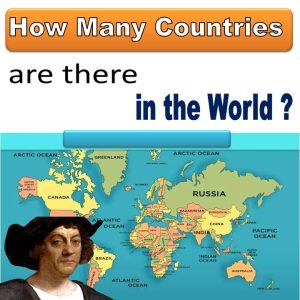Have you ever wondered, how many countries are there in the world? While it may seem like a fairly straightforward question, it’s actually quite complicated.
The problem is, it depends on who you ask as to what answer you get, and there isn’t one generally accepted answer. And the very word country has no official meaning. A good place to start might be an organisation like the United Nations.
There are currently 193 members of the UN. This is why this is generally the lowest number you’ll ever hear as to how many countries there are. But while the UN members are near-universally considered countries, there are plenty of more complex situations around the world in which there is disagreement about whether or not a country is actually a country.
For starters, staying with the UN, along with the 193 members, the UN also has two permanent non-member observer states. The Holy See, representing the Vatican City, and the State of Palestine. Despite not being a full member, Vatican City is a country and is recognised by everyone as such.
This is despite the fact that it’s a country within a city within a country, and small not only by country or city standards, but more comparable in size with that of a small village, with a population of around 500 and a land area of just half a square kilometer. So if Vatican City is a country, does that mean that Palestine is also a country too? Well, it’s complicated. The only reason the Holy See isn’t a full member is simply because… it doesn’t want to be.
It just never applied for full membership. The State of Palestine, on the other hand, does want to be a full member, and made an unsuccessful application in September of 2011. It does seem unlikely that Palestine will become a full UN member due to the process that is required to become one.
Palestine’s current observer state status was obtained in 2012 through a General Assembly vote, i.e. all 193 members have one vote each, and only a simple majority is required to pass. In order to gain full membership, however, the decision must first pass through the UN Security Council. The Security Council is made up of 15 members, 5 permanent members, also known as the Big Five, and 10 non-permanent members who serve for 2 years at a time.
The Big Five consists of China, France, Russia, the United Kingdom, and the United States, all of whom have veto power with regards to UN resolutions. This means that if any one of these 5 members vote against a resolution, it won’t get passed, regardless of how the other members voted. Because the United States is one of the members with veto power, Palestine would realistically never be able to make it through the process any time in the foreseeable future.
This is because the US is such a close ally of Israel. Both countries have argued that the Israeli-Palestinian conflict must first be resolved peacefully, before full recognition of a Palestinian state can take place. Around the time of Palestine’s failed membership application, President Obama had this to say.
And I am convinced that there is no shortcut to the end of a conflict that has endured for decades. Peace is hard work. Peace will not come through statements and resolutions at the United Nations.
If it were that easy, it would have been accomplished by now. Ultimately, it is the Israelis and the Palestinians, not us, who must reach agreement on the issues that divide them. Aside from full UN recognition, there are several other things that set Palestine apart from most countries.
First of all, they don’t actually have any legally defined borders, and the lines that are generally used to outline their claimed territories of the West Bank and the Gaza Strip are actually lines created in 1949 as part of an armistice agreement, and were never intended to be used as international borders. On top of this, control over these regions is extremely complicated, with Israel controlling much of what Palestine claims as its territory. This is generally regarded as an occupation, while Israeli settlements in the region are broadly regarded as being in violation of international law.
There’s also a disconnect between the West Bank and Gaza, which are effectively controlled by two separate governments. As of 2023, the state of Palestine is recognised by 138 of the 193 UN members, thus making it the most recognised non-member. Okay, moving on… The US State Department lists 195 independent countries, and these are the 193 members of the UN, the previously discussed Vatican City, as well as the Republic of Kosovo.
Kosovo is a partially recognised country in Eastern Europe that declared its independence from Serbia in 2008. However, Serbia rejects their independence and still views Kosovo as an autonomous province of the country. Kosovo has a predominantly Albanian population, and tensions with Serbia led to a war in the late 90s.
The Kosovo Liberation Army fought for their right to self-determination against Serbia, due to the persecution of the Albanian majority in the region. With a lot of assistance from NATO, which included an extensive bombing campaign that reached as far as Belgrade, the war ended with the KLA in control of most of Kosovo. No official transfer of sovereignty was ever signed, and thus remains a disputed territory to this day.
Currently 101 of the 193 members recognise Kosovo as a country. Kosovo hasn’t made an application for UN membership. This is because the UN Security Council’s Big Five is split on the issue of Kosovo independence.
While the UK, the US, and France all recognise Kosovo and have diplomatic relations with them, Russia and China do not. If Kosovo’s membership application was ever put before the Security Council, it would certainly be vetoed by Russia, a very close ally of Serbia. Kosovo is part of many international organisations, and just last year in 2022, Kosovo started its official application process to join the European Union.
Kosovo does have control over most of its claimed territory, excluding a portion of Northern Kosovo still under Serbian control. Relations between the two have seen some improvement since Kosovo’s independence declaration, especially in 2013 with the Brussels Agreement. This treaty began to normalise relations between the two sides, and contains several specific provisions on certain aspects of power and administration within Kosovo.
Now, according to other sources, there are 196 countries. This includes the previously mentioned 195 from the US State Department, plus one more… Taiwan. Here’s where we see why just using the UN’s numbers exclusively has its limitations.
A concise version for the sake of this video basically boils down to whether Taiwan is its own country, or part of China. While Taiwan is officially part of China, at least according to the UN anyway, the reality of the situation is entirely different. China has absolutely no actual jurisdiction over the island, and Taiwan very much operates as its own country in literally every single way.
Taiwan’s official name, by the way, is the Republic of China. Not to be confused with the People’s Republic of China, or as it’s more commonly known, well… China. The island of Taiwan, formerly known as Formosa, first came under Chinese control with the Qing Dynasty in 1683.
Then, fast forward about 200 years, and the island was captured by Japan. Back on the mainland, the Qing Dynasty was overthrown in the 1911 revolution. The Republic of China was established with the Nationalist Party as the government.
Not long after, a civil war broke out between this Nationalist government and the newly established Chinese Communist Party, or the CCP. We can now skip ahead to the end of World War II. The Allied forces issued Japan with a surrender ultimatum known as the Potsdam Declaration.
The agreement stated, among other things, that Japan must relinquish control of land that they had acquired via force, and this included the island of Taiwan obtained 50 years previously from the Qing Dynasty. The Allies gave Japan two choices. An unconditional surrender, or face, and I quote, prompt and utter destruction.
On the 2nd of September 1945, Japan signed the agreement, marking the official end of the Second World War. As per the Potsdam Agreement, sovereignty of Taiwan was therefore handed over to the Republic of China. Later that year, the United Nations was founded, with the Republic of China as one of its founding members and one of the permanent members of the Security Council.
The original Big Five were effectively the same as today, except with the Republic of China and the Soviet Union, instead of the People’s Republic of China and the Russian Federation, respectively. So remember that civil war in China? Well, it was sort of put on hold to fend off the Japanese, but with them out of the way, the two opposing Chinese factions could get back to fighting each other. The Communists completely overwhelmed the Nationalist forces, eventually causing them to retreat to the island of Taiwan in 1949.
This effectively ended the civil war, and led to the proclamation of the People’s Republic of China by the CCP. This then created an incredibly complicated situation in which there were effectively two Chinas. The People’s Republic of China controlled the mainland, while the Republic of China controlled Taiwan, but both claimed each other’s land.
Things remained like this for two decades, while the Republic of China continued to represent China at the United Nations as a government in exile. This was until 1971, when the UN General Assembly voted to replace the Republic of China with the People’s Republic of China as China’s sole representative. And given that the PRC claimed the island of Taiwan, and the ROC no longer had a seat at the UN, this explains why, even today, the official position of the UN is that Taiwan is part of China.
This is despite the fact that the PRC has never had any jurisdiction over the island in their history. Among the people of Taiwan, opinions on the country’s ambiguous political status are extremely varied. The overwhelming majority favour the status quo, at least for the time being, with a preference to leaning towards independence gradually.
Practically speaking, Taiwan is pretty much like any other country. They have their own president, their own government, their own military, and their own passports. Which, by the way, have actually been redesigned recently to put more emphasis on Taiwan.
They even take part in sporting events such as the Olympics and the FIFA World Cup. Albeit under the intentionally ambiguous pseudonym of Chinese Taipei. There are very few countries that have official diplomatic relations with Taiwan, but many countries do have unofficial relations and Taiwanese embassies in their country.
Well, they’re not actually called embassies, they’re called things like the Taipei Representative Office, or something similar. Countries tend to avoid officially recognising Taiwan because doing so would cease any formal relations between that country and China. This is the reason why the US State Department lists 195 countries and excludes Taiwan.
This is despite the fact that the US and Taiwan are actually very close allies in reality. So, are we all clear on the situation with Taiwan? No? Well, nobody really is, but we have to move on. Let’s now take a look at the United Kingdom.
The UK is often referred to as a country of countries, consisting of Scotland, England, Wales, and Northern Ireland. So is the UK one country, or four countries? Well, first of all, it’s not even clear how many countries there are in the UK. While Northern Ireland is practically similar to the other three in most ways, it’s often not considered a country, but rather a province of the UK.
The population of Northern Ireland is generally split on the issue of its political status, with the majority favouring to continue as part of the UK, but a sizable minority want to join Ireland, unifying the whole island. For this reason, Northern Ireland doesn’t even have its own official flag, while the other three do. The St. Patrick’s Saltire is sometimes used unofficially to distinguish Northern Ireland from the rest of the UK, but pretty much any flag flown to represent the country can cause controversy.
A more popular, though still divisive, symbol is the Ulster Banner, which is generally used to represent Northern Ireland in sporting events. Speaking of which, things get further complicated when talking about sports. Whether the UK plays as one country or four countries varies depending on the particular sport.
For the Olympic Games, for example, it’s Team GB, but when it comes to football, we often talk about the home nations, with all four countries having their own national team. So the UK is made up of 4 or 3 countries, and while these countries are not independent countries or sovereign states, they are still countries. Whether these should be counted or not when determining how many countries there are in the world is debatable, with no definitive answer.
The term for a country within a country is a constituent country, and is actually not unique to the UK. For example, the Netherlands is a constituent country within the Kingdom of the Netherlands, which contains 3 other countries, Aruba, Curaçao, and Saint Martin. The Netherlands is in Europe, while the other three are island countries in the Caribbean some 5,000 miles away.
To further complicate matters, the Netherlands is made up of 12 provinces in Europe, as well as 3 special municipalities, also in the Caribbean. These are Bonaire, Saint Eustatius, and Ceiba, collectively referred to as the Caribbean Netherlands. The term Dutch Caribbean is used to refer to all the Caribbean islands within the Kingdom of the Netherlands.
All four countries within the Kingdom are considered equal, but in reality 98% of both the population and land area are within the 12 European provinces. Another example would be the Kingdom of Denmark, which holds sovereignty over the two autonomous countries of Greenland and the Faroe Islands. Greenland being the world’s largest island that is not a continent, and the Faroe Islands are a small archipelago north of Scotland.
But despite Greenland being over 1,500 times the size of the Faroe Islands, they both have similar populations of around 55,000. There’s also French Polynesia, which is an overseas country of the French Republic, made up of several island countries in the South Pacific, most notable of which is the island of Tahiti. Then we come to a slightly more complicated situation with New Zealand, and the countries of Nui and the Cook Islands, who are in an agreement known as Free Association.
There are only 3 other countries in the world under Free Association, and these are the Marshall Islands, the Federated States of Micronesia, and Palau, all of which are in Free Association with the United States. The major difference is that all 3 of these countries are members of the UN, while Nui and the Cook Islands are not. Freely Associated States really blur the lines about the very concept of independence.
They could be considered both independent or not, depending on the context. Regardless of UN status, all 5 of these countries have a more powerful country that is responsible for their defence. But things get even trickier when we realise that this isn’t even unique to Freely Associated States.
Several other small countries like Andorra, Monaco, and San Marino, to name a few, have other countries responsible for their defence as well. And finally, we come to a category of countries, and I use the term loosely, that have received little or no recognition. One example would be Northern Cyprus, a Turkish-declared puppet state that was established after an invasion of the island in 1974, and is recognised by exactly one UN member.
Turkey. There’s also Western Sahara, a former Spanish colony that became disputed after Spain withdrew from the region. I have entire videos on both these topics if you’d like to learn more.
Of course, there are other examples, all of which have received varying degrees of recognition, albeit extremely limited, and in some cases, not by any UN members. External recognition is a key attribute to be considered a country, and therefore it would be a bit of a stretch to call any of them countries at the moment. However, we can look towards the future and see what might change in the coming years.
For example, my own country, Scotland, had an independence referendum in 2014. The result was 55% voting no, and thus Scotland remained part of the UK. However, support for independence is still strong, and there has even been talk recently about a second referendum.
So it is possible that Scotland will become an independent country someday. There’s also Catalonia, an autonomous community of Spain with a long and complicated history with the Spanish Crown. Catalonia held a referendum against the will of Madrid.
The result was strongly in favour of independence, although it was boycotted by those who wanted to remain part of Spain, and denounced by the Spanish government as being held illegally. At the complete opposite side of the world, there’s Bougainville, an autonomous region of Papua New Guinea. In 2019, a non-binding independence referendum was held, resulting in an overwhelming majority voting for independence.
Regional authorities have set 2027 as the deadline for independence, but ultimately the final decision rests with Papua New Guinea. And there are so many more independence movements throughout the world, far too many to mention here. So back to the original question at hand, how many countries are there in the world? Well, there really are no right or wrong answers.
Well, I mean there are wrong answers. 10, for example, is a wrong answer. But because of the ambiguity of the word country, there is no generally accepted answer.
That being said, if you really want some numbers, some possible answers would be… Just the members of the UN. Counting the Vatican City, since it’s also a country. Counting Taiwan, a country to most people who are not Chinese or have major ties to the country.
Counting Kosovo or Palestine, the most recognised countries not in the UN. Counting both Kosovo and Palestine. And then we could count some or even all of the remaining unrecognised countries.
One step up and we could start counting constituent countries, as well as Nui and the Cook Islands, French Polynesia, Greenland, and really come up with a near-infinite number of answers. Probably the most widely accepted number is 196, albeit with disagreement on which is the 196th country, Kosovo or Palestine. Some countries do recognise both, and of course you’re free to make your own judgement.
The question of how many countries there are in the world is a difficult one, with many many different factors to consider. But while the lack of simplicity in the question may be frustrating, we can choose to think of it as a great opportunity to learn more about this complicated world we live in.
- This airport is gradually sinking under the sea29 years ago in September 1994, Japan’s Kansai International Airport… Read more: This airport is gradually sinking under the sea
- Do this Now to get High Salary IT Job in India in 2024Some IT jobs are there, in which your salary after… Read more: Do this Now to get High Salary IT Job in India in 2024
- After 12th You Need to Know this to Start Your Coding CareerThere are many courses in computer fields to make a… Read more: After 12th You Need to Know this to Start Your Coding Career
- Govt job Vacancy of April 2024The video link provided at the bottom of this article… Read more: Govt job Vacancy of April 2024
- UGC New Notice on PhD AdmissionUGC NET, CSIR NET, GATE, Asst Professor Job 2024 This… Read more: UGC New Notice on PhD Admission
- What to do After Class 12th PCM ? The best 10 Career OptionsIf you are a science-math student, 12th is almost complete.… Read more: What to do After Class 12th PCM ? The best 10 Career Options
- Read this before preparing for Government JobsWe are going to talk about a subject which is… Read more: Read this before preparing for Government Jobs
- How Many Countries are There in the World ?Have you ever wondered, how many countries are there in… Read more: How Many Countries are There in the World ?
- Ajit Doval: The Indian James BondThis is about a person who is also known as… Read more: Ajit Doval: The Indian James Bond
- Latest Govt Job Vacancies February 2024 : Apply NowGovt job vacancies for the Month of February and March… Read more: Latest Govt Job Vacancies February 2024 : Apply Now
- JDDC CONSTABLEJob Notification Details for UP Police Constable (SPORTS QUATA )… Read more: JDDC CONSTABLE
- UP POLICE CONSTABLE RECRUITMENT 2023-2024Job Notification Details for UP Police Constable Online 2023-24 UTTAR… Read more: UP POLICE CONSTABLE RECRUITMENT 2023-2024










